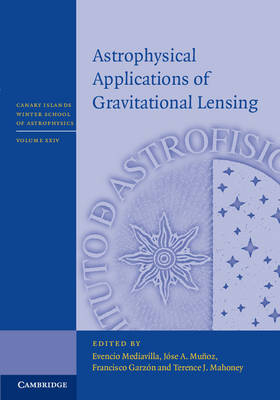
Astrophysical Applications of Gravitational Lensing
Seiten
2016
Cambridge University Press (Verlag)
978-1-107-07854-3 (ISBN)
Cambridge University Press (Verlag)
978-1-107-07854-3 (ISBN)
Covering topics from lensing basics, quasars, clusters and large-scale structures to tutorials on lens and microlensing modelling and the future of strong lensing, this is an ideal guide for postgraduate students and practising researchers in the use of gravitational lenses as an essential tool in their investigations.
Gravitational lenses offer the best, and sometimes the only, means of tackling key problems in many fields of astrophysics and cosmology. According to Einstein's theory, the curvature of light-rays increases with mass; gravitational lenses can be used to map the distribution of mass in a Universe in which virtually all matter is dark matter of an unknown nature. Gravitational lensing has significantly improved our knowledge of many astrophysical phenomena, such as exoplanets, galaxies, active galactic nuclei, quasars, clusters, large-scale structure and the Universe itself. All these topics are covered fully in this book, together with two tutorials on lens and microlensing modelling. The future of lensing in relation to large surveys and the anticipated discoveries of thousands more gravitational lenses is also discussed, making this volume an ideal guide for postgraduate students and practising researchers in the use of gravitational lenses as a tool in their investigations.
Gravitational lenses offer the best, and sometimes the only, means of tackling key problems in many fields of astrophysics and cosmology. According to Einstein's theory, the curvature of light-rays increases with mass; gravitational lenses can be used to map the distribution of mass in a Universe in which virtually all matter is dark matter of an unknown nature. Gravitational lensing has significantly improved our knowledge of many astrophysical phenomena, such as exoplanets, galaxies, active galactic nuclei, quasars, clusters, large-scale structure and the Universe itself. All these topics are covered fully in this book, together with two tutorials on lens and microlensing modelling. The future of lensing in relation to large surveys and the anticipated discoveries of thousands more gravitational lenses is also discussed, making this volume an ideal guide for postgraduate students and practising researchers in the use of gravitational lenses as a tool in their investigations.
Contributors; Participants; Preface; Acknowledgements; 1. Lensing basics Sherry H. Suyu; 2. Exoplanet microlensing Andrew Gould; 3. Case studies of microlensing Veronica Motta and Emilio Falco; 4. Microlensing of quasars and AGN Joachim Wambsganss; 5. DM in clusters and large-scale structure Peter Schneider; 6. The future of strong lensing Chris Fassnacht; 7. Methods for strong lens modelling Charles Keeton; 8. Tutorial on inverse ray shooting Jorge Jimenez-Vicente.
| Erscheint lt. Verlag | 6.10.2016 |
|---|---|
| Reihe/Serie | Canary Islands Winter School of Astrophysics |
| Zusatzinfo | 12 Tables, black and white; 111 Halftones, black and white; 25 Line drawings, black and white |
| Verlagsort | Cambridge |
| Sprache | englisch |
| Maße | 178 x 252 mm |
| Gewicht | 750 g |
| Themenwelt | Naturwissenschaften ► Physik / Astronomie ► Astronomie / Astrophysik |
| ISBN-10 | 1-107-07854-7 / 1107078547 |
| ISBN-13 | 978-1-107-07854-3 / 9781107078543 |
| Zustand | Neuware |
| Haben Sie eine Frage zum Produkt? |
Mehr entdecken
aus dem Bereich
aus dem Bereich
Grundlagen, Anwendungen in Astrophysik und Kosmologie sowie …
Buch | Softcover (2022)
Springer Spektrum (Verlag)
49,99 €
die Geschichte und Erforschung unserer Galaxie
Buch | Hardcover (2023)
C.Bertelsmann (Verlag)
30,00 €
Von Hubble-, James-Webb- und anderen Großteleskopen bis zu …
Buch | Softcover (2024)
Springer (Verlag)
22,99 €


